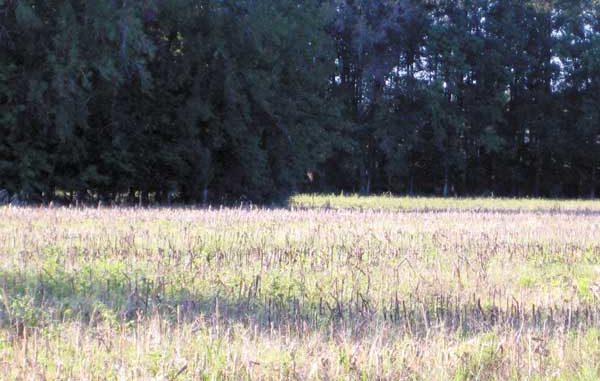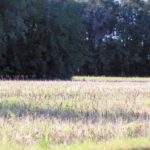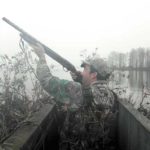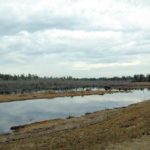
Preferred natural foods for deer, turkey, and quail quickly become unavailable as winter sets in across South Carolina.By December and January, mast crops within forests are often completely consumed by a full complement of wildlife. Deer are now restricted to cool-season grasses, scattered mast crops and woody browse inherently low in nutritional value.
Turkeys and bobwhite quail survive on cool-season grass, weed seeds and insects. With a small change in farming practices, native wildlife will continue to flourish throughout the winter. Needless to say, the spent crop fields become a prime location to work the dogs and collect the groceries for a fried quail dinner.
The harvest season for this year’s agriculture crops is coming to a close as winter sets in. The generations of agriculture throughout both North Carolina and South Carolina routinely supplement wildlife throughout a large portion of the year with food and vital cover.
Luckily, today’s harvesting machines are still inefficient enough to leave a residual winter food source for wildlife. However, normal farming practices lend to “winterizing” or tillage with a cover crop. While the fall tillage is beneficial to the farmer, wildlife are negatively affected. Turning the spent crops will make a large portion of those grains unavailable for smaller game and increase the challenge for larger game to gobble up nutrient-rich food resources.
Not only do spent crops provide crucial nutrition for wildlife, but most fields have weedy invaders within the harvested areas. The combination of leftover crop stalks and weeds provides excellent cover and bugging areas for game birds. Encourage farmers to eliminate tilling grain fields during the winter. Avoiding winter tillage will promote the sustainability of wildlife on your farm.
They’re back with a new mixed bag
Plumes of frigid air drift south more routinely this month, carrying thousands of ducks on the Carolina express into our swamps, bays, and flooded grain impoundments. Since the November short season is over, early ducks are getting their bellies full munching away at a full complement of flooded grains, and new ducks are coming down with each cold blast.
The third and longest segment of waterfowl season opens this month to complete the 60-day season prescribed for the Atlantic Flyway. While earlier seasons can be productive, the final season is recognized as “the time to go,” and many duck hunters are starting preparations for their first duck day of the year.
Although the total bag limit is similar to previous seasons, the U.S. Fish and Wildlife Service (USFWS) has made a few changes for duck hunters within the Atlantic Flyway. The USFWS routinely studies the population trends of each duck species within each flyway and makes changes to bag limits accordingly.
Since the population of wood duck, commonly referred to as the “summer duck,” is steadily on the rise along the Atlantic Flyway, the limit has risen from two to three woodies per day. While most regulation changes have little effect on some hunters, the extra woody directly benefits the majority of hunters wading through swamps at the crack of dawn.
If you didn’t get a chance to bag the ever-so-cherished canvasback last year, there’s no need to get excited about knocking down one this season; they are off-limits. After having a bumper crop of canvasbacks last year, followed by this year’s immense decline, the USFWS recommended closing the season on the Atlantic Flyway to allow time for renourishment.
Continued long-term declines within scaup populations have initiated a hybrid bag limit, only allowing one scaup per day before Jan. 2 and two scaup afterwards. The reduced early-season bag limit will relieve pressure on these species, reducing the overall harvest.
Plow those fire breaks
With the last, few remaining leaves falling to the forest floor, trees are entering their winter dormant state, slowing growth to turtle-class speed. Only a few cool-season plants are growing. Winter prescribed burns are on the horizon, and December is a prime time to re-establish or install new fire breaks.
Prescribed fire is the most-economical tool available to improve wildlife habitat, directly affecting deer, turkey, and quail. Winter understory burns are recommended to reduce the amount of woody brush, to promote nutritious browse, open up travel lanes, and to promote nutritional herbs and legumes for wildlife.
All burning plans should include a series of plow lines or fire breaks. Fire breaks should be installed with either a fire plow pulled by heavy equipment or a common farm tractor pulling a disc. Depending on the ground cover, making one or two passes with a tractor and a disc generally eliminates possible accumulations of fuel to feed the fire across the plowed area, further containing the fire to the burn area.
Install a liberal perimeter fire break and numerous narrower fire breaks that bisect the burn area to ensure a safe and controlled burn. Having good fire breaks in place is, in many instances, the difference between a controlled burn and a raging forest fire.
Drop the water level, solve pond problems
Want an inexpensive way to revive a struggling pond?
It’s called “winter drawdown.”
Lowering the water level by 30 to 50 percent of its full-pool volume will take care of a host of common issues that trouble pond owners. Lowering the water level exposes the shallow shelf around the pond, concentrating the water and fish into deeper pools. While winter drawdown will never be the snake oil to fix everything, it is a valuable pond-management tool.
Many ponds are vulnerable to aggressive aquatic weed growth covering the shallow areas. Winter drawdown is an effective way to reduce the coverage of these pesky nuisances. The exposed weeds will quickly die because of the freezing temperatures typical during the winter months.
Catching quality bass and/or sunfish will almost always be the primary goal of a proud pond owner The predator-prey balance within a pond will peak within three to five years of initial stocking, providing outstanding fishing.
Levels of reproduction among predator/prey species, predation, harvest and/or lack of harvest quickly discombobulates the fisheries balance. The prey species — bluegill, crappie, and other sunfish — usually overpopulate more quickly than their predators. The winter drawdown concentrates the vulnerable sunfish, allowing predator fish to feed and return the pond to its much needed balanced predator/prey ratio.








Be the first to comment